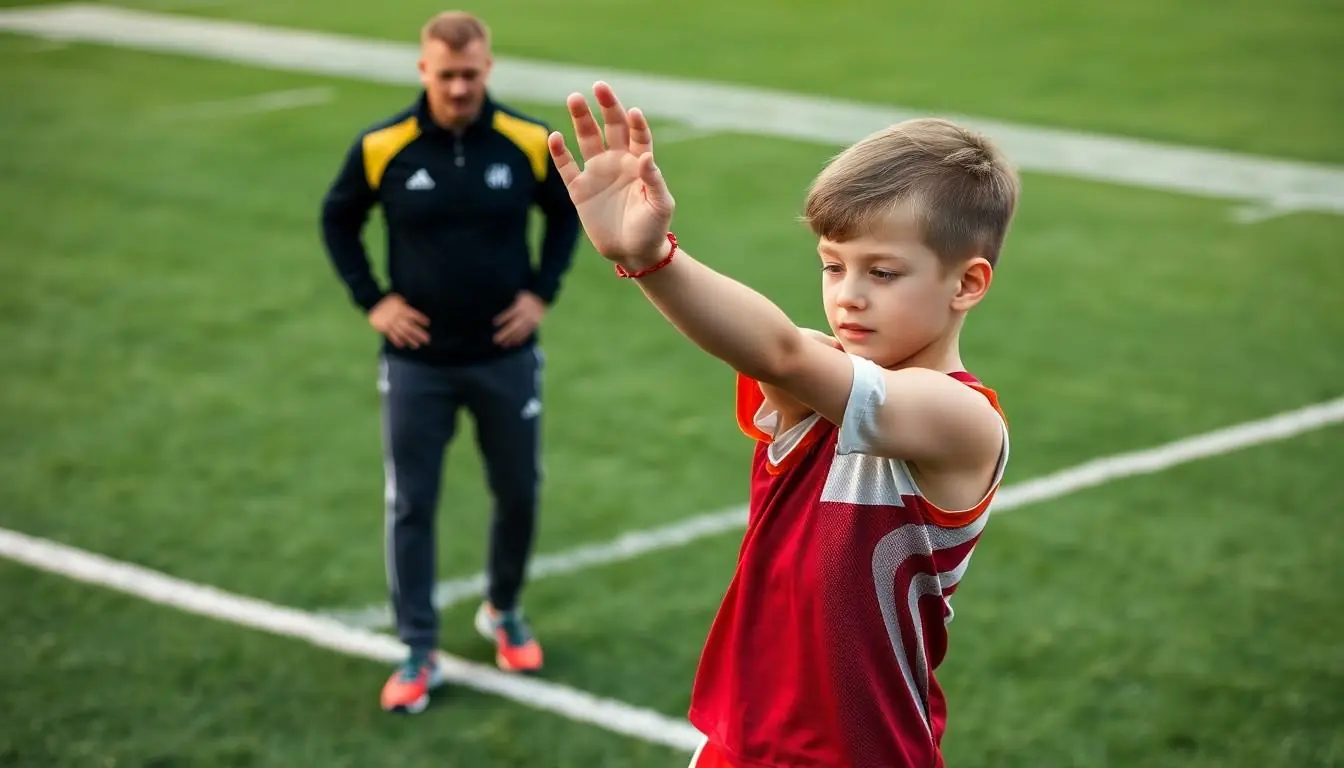Table of Contents
ToggleWhen kids sprint across soccer fields or leap for basketball hoops they’re not just having fun – they’re also putting their growing bodies to the test. Sports medicine for children has evolved into a specialized field that keeps young athletes bouncing back from injuries faster than a rubber ball.
Today’s youth sports scene isn’t just about participation trophies and orange slices at halftime. With over 30 million children participating in organized sports each year medical professionals have developed kid-specific approaches to prevent treat and rehabilitate sports-related injuries. From growth plate concerns to proper conditioning techniques sports medicine specialists work like behind-the-scenes coaches keeping young champions safe and healthy.
Common Sports Injuries in Children and Adolescents
Young athletes experience distinct injury patterns due to their developing bodies and active participation in sports. Medical data indicates that 3.5 million sports injuries occur annually in children under 14 years old.
Growth Plate Injuries
Growth plate injuries affect the developing tissue at the end of long bones in children. These injuries account for 15-30% of childhood bone injuries, occurring most frequently in contact sports like football and basketball. The growth plates remain vulnerable until they close, typically between ages 13-15 for girls and 15-17 for boys. Damage to growth plates manifests through symptoms including persistent pain, visible deformity and limited movement in the affected area. X-rays confirm growth plate fractures, requiring immediate medical attention to prevent long-term complications like uneven limb growth or joint problems.
Overuse Injuries
Overuse injuries result from repetitive stress on muscles, bones or joints without adequate recovery time. Sports specialization increases these injuries by 50% compared to multi-sport participation. Common examples include swimmer’s shoulder, runner’s knee and Little League elbow. Physical signs include localized pain, swelling and decreased performance in specific movements. Athletes who train more than 15 hours weekly face a 2x higher risk of overuse injuries compared to those training fewer hours.
Concussions and Head Trauma
Sports-related concussions affect 1.1-1.9 million youth athletes annually in the United States. Contact sports generate the highest concussion rates with football leading at 60% of reported cases. Athletes display immediate symptoms including headache, confusion, dizziness and sensitivity to light. Baseline cognitive testing helps medical professionals track recovery progress. Return-to-play protocols require a minimum 5-step progression over 7 days, ensuring complete symptom resolution before full sport participation resumes.
Preventive Care in Youth Sports
Preventive care forms the cornerstone of youth sports medicine, focusing on proactive measures to reduce injury risks. Medical professionals implement comprehensive strategies to protect young athletes during their physical development stages.
Pre-Participation Physical Examinations
Pre-participation physical examinations (PPE) identify potential health risks before athletic participation begins. These screenings evaluate cardiovascular health, musculoskeletal function, vision status, immunization records. Medical professionals examine growth plate development, joint flexibility, muscle strength balance during these assessments. PPE screenings detect underlying conditions in 3-7% of young athletes that require medical intervention before sports participation. Athletes complete a detailed health history questionnaire covering previous injuries, medications, allergies, family medical conditions.
Proper Training and Conditioning
Training programs adapt to young athletes’ developmental stages across different age groups. Sports-specific conditioning incorporates adequate warm-up routines, flexibility exercises, strength training protocols. Certified trainers monitor workout intensity levels, maintaining a 10% weekly increase limit in training volume. Rest periods between training sessions allow 24-48 hours for muscle recovery. Programs emphasize proper form, technique development, balanced muscle strengthening to prevent overuse injuries.
Safe Return-to-Play Guidelines
Return-to-play protocols follow evidence-based progression stages after injury recovery. Athletes demonstrate full range of motion, strength restoration, sport-specific skill mastery before resuming competition. Medical clearance requires passing functional tests, balance assessments, coordination drills specific to their sport. Gradual activity progression starts at 25% intensity, increasing through monitored phases. Contact sport athletes complete additional impact testing, cognitive evaluations before receiving final clearance.
Treatment Approaches for Young Athletes
Medical professionals adapt treatment strategies for young athletes based on their developmental stage growth patterns. Modern sports medicine integrates specialized protocols that account for both physical maturity levels and injury types.
Age-Appropriate Rehabilitation
Rehabilitation programs for young athletes focus on developmental milestones at each growth stage. Children ages 6-12 receive movement-based exercises that enhance coordination through playful activities. Teenagers ages 13-17 engage in progressive strength training with proper form monitoring. A structured timeline guides the rehabilitation process:
| Age Group | Focus Areas | Recovery Timeline |
|---|---|---|
| 6-12 years | Basic movements, flexibility | 20-30% longer than adults |
| 13-15 years | Strength, coordination | 10-20% longer than adults |
| 16-17 years | Sport-specific training | Similar to adult timeline |
Pain Management for Children
Pain management protocols utilize child-specific medication dosages combined with non-pharmaceutical approaches. Ice therapy sessions last 10-15 minutes with 2-hour intervals between applications. Physical therapists incorporate distraction techniques during treatment sessions. Pain assessment tools include:
- Visual analog scales with faces
- Numeric rating systems from 1-10
- Color-coded pain charts
- Activity tolerance measurements
- Behavioral observation scales
Physical Therapy Techniques
- Balance training on stability boards
- Manual therapy with gentle mobilization
- Neuromuscular exercises using resistance bands
- Proprioceptive training through controlled movements
- Sport-specific drills modified for recovery phases
Psychological Aspects of Sports Medicine
The psychological impact of sports injuries on young athletes extends beyond physical challenges. Mental health professionals play a crucial role in supporting children through injury recovery, rehabilitation, and return to sports participation.
Managing Performance Anxiety
Performance anxiety affects 45% of young athletes, manifesting through physical symptoms like rapid heartbeat, sweating and nausea. Sports psychologists utilize cognitive behavioral techniques to help athletes develop coping mechanisms for competitive stress. Relaxation exercises, including deep breathing and progressive muscle relaxation, reduce anxiety levels in 80% of youth participants. Mental rehearsal techniques enhance performance confidence while decreasing pre-competition nervousness. Athletes who practice visualization techniques show a 35% improvement in performance metrics compared to those who don’t engage in mental preparation.
Coping with Recovery Time
Recovery periods create significant emotional challenges for young athletes, with 65% reporting feelings of isolation from their team. Sports medicine professionals incorporate goal-setting strategies to maintain motivation during rehabilitation phases. Weekly milestone achievements help track progress, giving athletes tangible evidence of their recovery journey. Support groups connecting injured athletes reduce depression symptoms by 40% during extended recovery periods. Athletic trainers integrate social support mechanisms into treatment plans, encouraging team involvement through modified participation roles like assistant coaching or statistical tracking.
Role of Parents and Coaches
Parents and coaches serve as the primary advocates for young athletes’ health and safety in sports. Their active involvement in monitoring and supporting youth athletes creates a foundation for injury prevention and proper medical care.
Recognizing Warning Signs
Parents and coaches monitor athletes for key indicators of potential injuries or health concerns. Physical signs include limping, decreased range of motion or visible swelling in joints after activity. Behavioral changes such as reluctance to participate, increased fatigue or declining performance signal potential issues. Athletes experiencing headaches, dizziness or confusion require immediate medical evaluation. Changes in sleep patterns, appetite or mood indicate possible overtraining syndrome. Regular communication between parents, coaches and athletes helps identify these warning signs early, enabling prompt intervention when needed.
Creating a Safe Training Environment
Proper equipment inspection ensures all protective gear fits correctly and meets safety standards. Training facilities maintain clean, well-lit spaces with appropriate padding and shock-absorbing surfaces. Coaches implement structured warm-up routines lasting 10-15 minutes before intense activity. Practice sessions include regular water breaks every 15-20 minutes during hot weather. Age-appropriate training loads follow the 10% rule for weekly intensity increases. Emergency action plans outline specific steps for handling injuries, including contact information for medical professionals. Weather monitoring protocols protect athletes from extreme conditions through modified or cancelled sessions.
Long-Term Health Considerations
Long-term health outcomes in youth sports require careful monitoring and management to ensure optimal development. Early intervention and proper medical care create lasting impacts on young athletes’ future well-being.
Impact on Growth and Development
Growth plate injuries during youth sports affect bone development in 15-30% of cases, potentially leading to limb length discrepancies or angular deformities. Regular monitoring through specialized growth charts tracks athletic children’s development patterns, identifying abnormalities early. Sports medicine specialists evaluate bone density, muscle mass development through diagnostic tools like DEXA scans showing 5-10% variations in athletic versus non-athletic children. Physical development milestones include peak height velocity periods occurring at ages 11-12 for girls and 13-14 for boys, requiring adjusted training protocols. Growth-related complications from overtraining manifest through delayed puberty markers or reduced bone density in 8% of young athletes.
Preventing Chronic Conditions
| Sport Type | Associated Risk | Prevention Rate with Early Intervention |
|---|---|---|
| Running | Knee OA | 65% reduction |
| Swimming | Shoulder Issues | 55% reduction |
| Football | Back Problems | 45% reduction |
Conclusion
Sports medicine for kids has evolved into a comprehensive field that addresses the unique needs of young athletes. From preventive care and specialized treatment approaches to psychological support and long-term health monitoring the field continues to advance.
Parents coaches and healthcare providers must work together to create a safe environment for young athletes. This collaborative approach helps ensure proper injury prevention diagnosis and treatment while supporting the physical and emotional well-being of children in sports.
By prioritizing youth-specific protocols and maintaining open communication among all stakeholders young athletes can continue to enjoy their sports activities safely and develop into healthy successful competitors.





